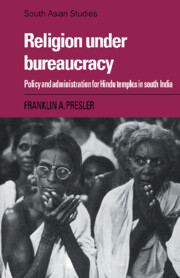Book contents
- Frontmatter
- Contents
- Dedication
- Preface
- Notes on sources, abbreviations and transliteration
- Map
- 1 Introduction: studying religion-state relations
- 2 The temple connection in the nineteenth century
- 3 Governance: the necessity for order
- 4 Governance: trustees and the courts
- 5 Economy: the problem of controlling land
- 6 Economy: the temple's weakness as landlord
- 7 Religion: purifying and organizing Hinduism
- 8 Religion: controlling the priesthood
- 9 Conclusion
- Bibliography
- Index
4 - Governance: trustees and the courts
Published online by Cambridge University Press: 03 October 2009
- Frontmatter
- Contents
- Dedication
- Preface
- Notes on sources, abbreviations and transliteration
- Map
- 1 Introduction: studying religion-state relations
- 2 The temple connection in the nineteenth century
- 3 Governance: the necessity for order
- 4 Governance: trustees and the courts
- 5 Economy: the problem of controlling land
- 6 Economy: the temple's weakness as landlord
- 7 Religion: purifying and organizing Hinduism
- 8 Religion: controlling the priesthood
- 9 Conclusion
- Bibliography
- Index
Summary
An analysis of HRCE governance requires a closer look at the temple's top legal authority, the Board of Trustees. Boards usually have three to five members, and appointments are usually highly coveted. Trustees receive special consideration in temple rituals, in the receipt of honors and in other dignities; they can shape the consideration others receive. Trustees also influence the way the temple's material resources are used. Trustees may be able to help a friend obtain a lease to temple land, rent a space within the temple to sell ritual necessities, or obtain lucrative building and renovation (tiruppani) contracts: Even modestly endowed institutions possess land and income that, when used carefully, can be extremely influential.
For the HRCE, trustees are the wild card upsetting the smooth flow of temple management. Gaining control over trustees, itself no easy task, is a precondition to controlling the temple. HRCE officers report that trustees are seldom truly dedicated to their temples. They use their offices to elevate their own prestige, to further their political careers, or to increase their personal income. It is a theme which has been sounded many times over the years: the typical trustee is ambitious, unscrupulous, corrupt, the root cause of temple disorder and decline.
If the temple were reconstructed according to the HRCE's ideal image, there probably would be no trustees at all. But in that case the conclusion would be almost inescapable that temples are state institutions. Since the HRCE is nominally committed to secular principles, it has limited itself to trying to control who gets trusteeships and how trustees conduct themselves in office.
- Type
- Chapter
- Information
- Religion under BureaucracyPolicy and Administration for Hindu Temples in South India, pp. 57 - 72Publisher: Cambridge University PressPrint publication year: 1988



